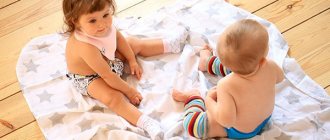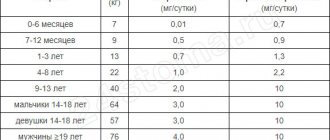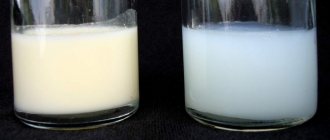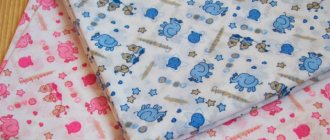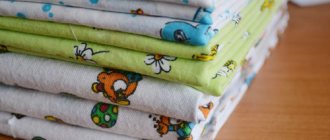Why iron diapers?
The habit of steaming babies' clothes and diapers has been criticized by immunologists. Previously, young mothers were deprived of such benefits of civilization as disposable diapers, automatic machines and baby powders, and careful ironing made sense.
A newborn baby is defenseless against infections, especially in the first 2 weeks, until the umbilical wound has healed. Lacking convenient hygiene products, we previously used reusable cloth diapers. Diapers inevitably absorbed leaking contents, becoming a breeding ground for bacteria.
Hand washing did not provide sterility, and boiling made the material too harsh for delicate skin. The only way to provide the child with clean diapers was ironing on both sides. The high temperature killed germs, and mothers could not be afraid of introducing an infection into the unhealed navel. For the same reasons, at first it was recommended to bathe the child in a weak solution of potassium permanganate and regularly treat the wound with an alcohol antiseptic.
Now there is no requirement to additionally disinfect diapers after washing. When using diapers, the baby's things remain practically clean. Washing at 90°C with detergent does a good job of disinfecting fabric.
Creating sterility by ironing is a myth. Particles of dust and microbes from the air instantly land on an item coming out of the iron, but they are unlikely to cause any significant harm to the child. The immune system must train itself to fight bacteria and viruses. Therefore, many pediatricians are against creating artificial sterility around a newborn and recommend not to be overzealous with disinfecting children's undershirts and toys.
The problem of “ironing or not” lies rather on an aesthetic plane. Ironed items look neater than those simply taken off the line. Many people are accustomed to ironing clothes and linens, regardless of whether there is any practical purpose other than to look neat. They just don't like wrinkled things.
But there is another category of mothers who refuse to iron diapers in favor of relaxation and free time. A healthy child will not suffer from this in any way. It is enough to follow the rules:
- wash children's underwear separately from adults;
- choose high temperature mode;
- use hypoallergenic baby powder;
- dry at home so that street dust does not settle on the fabric;
- Carefully hang the washed laundry, carefully straightening out the folds.
The exception is new items from the store. They must be washed and ironed on both sides. It is not known where they were stored, it is better to play it safe and thoroughly disinfect the laundry.
It won’t hurt to steam the diapers and clothes of a weakened, premature baby. If a child suffers from diaper rash, irritation, dermatitis, the skin should not come into contact with folds, seams and rough fabric.
What happens if you don't iron it on both sides?
In the first month of life, all the baby’s clothes are ironed on both sides. This is done in order to maximally disinfect the laundry from various microorganisms, making it soft and comfortable. If you haven’t ironed the back side once or twice, then nothing bad will happen, of course, but it is advisable to be careful and find time for quality ironing.
Each mother independently determines whether to iron the baby’s things or not, how often, on both sides or on one, whether it is necessary to iron the newborn’s diapers based on busyness, personal preferences and necessity.
At what age should children's clothes be ironed?
The first months of life, a newborn needs special care. Its own immunity has not yet been formed; the body is protected only by antibodies received from the mother in the womb and through breast milk.
The main entry point for infections in the first days is the umbilical wound. Until it heals, it is better to avoid contact with dirt. Each child's scar heals differently, but on average it takes 14 days. To prevent inflammation, it is advisable to iron undershirts, rompers and diapers. With a healed navel - it’s no longer necessary.
Then each mother makes her own decision whether to iron the clothes. Arriving from the maternity hospital, the child is faced with an attack of foreign microflora. On the one hand, he must get used to his natural habitat, on the other hand, he must not catch a serious infection.
The task of parents is to create conditions where the newborn is well protected from pathogenic microbes, but is not in sterile cleanliness. It is useful for the immune system to have something to “train” on.
The adaptation period lasts about three months. From this age, it makes no sense to disinfect everything the child touches. His body is already able to cope with microbes.
Should I iron my newborn's clothes?
In matters of caring for a baby, we are accustomed to listening to the advice of doctors, the older generation, and experienced friends. We follow certain canons developed over many years. After all, you want to do everything “as it should” and not do it “as it shouldn’t.” Should a newborn's diapers be ironed? You won’t believe it, but this is the question that causes the most intense discussions on women’s forums.
Moms are divided into two camps. The former iron diapers and all children's things on both sides, the latter claim that ironing is a completely useless activity that is not worth wasting precious time on. The former accuse the latter of sloppiness, untidiness and uncleanliness, while the latter accuse the former of excessive pedantry and outdated views. How to reconcile two warring camps? Is there any scientific view on the issue of ironing baby diapers?
Should I iron my newborn's clothes? — This question arises for young parents immediately after the birth of their baby. The older generation claims that this is necessary, but in the modern world, much that our mothers and grandmothers did is considered absolutely useless. What to do with the baby's clothes and diapers? And if processing is needed, then how to make this process fast and high-quality at the same time? You will learn about this in this article.
To iron or not?
There are still discussions on this issue, which do not lead to a unanimous answer. Many mothers diligently iron all the things of their newborn baby on both sides, while other mothers shy away from this process, considering it completely useless. You must make the final decision regarding this important point in caring for your baby yourself, based on your own beliefs.
When the baby's clothes are ironed with steam, all germs that could easily get on them while drying clothes on the balcony are destroyed.
We suggest you read What you need to do to prevent the item from fading
Important! This is an argument that is given in response to the statement that when washing clothes at 90 degrees in a washing machine, all microbes are destroyed. Do not forget about the drying process, when clothes are subjected to a new “attack” of pathogenic bacteria.
In order for the umbilical wound to heal as quickly and without problems as possible, you should definitely iron your underwear, because an open wound is a kind of “bait” for infections.
In the first months of his life, a baby’s skin is extremely sensitive and is not fully adapted to the often aggressive factors of everyday life. By ironing the fabric, you will eliminate the remnants of the detergent, make it softer and more pleasant, and therefore less “shocking” for the baby’s epidermis.
New, only purchased items are required
Source
I'm wondering how mandatory it is to iron baby diapers and sheets. All modern mothers have washing machines with a boiling mode and germs are killed during washing, and if you don’t get carried away with the spin cycle, then for smoothness it’s enough just to flatten the diaper on all sides and when it dries, it won’t be wrinkled.
I realized this only when my daughter was 8 months old, and before that I spent at least an hour and a half on ironing every day. Last summer, my daughter was hot in diapers and we didn’t put diapers on the child in the hot weather. I don’t think anyone has any problems with washing, but ironing really bothered me. I'm interested in the opinion of forum members - is it necessary to iron or not?
My daughter is three months old - I don’t iron anything at all. Without consequences. True, there is a dryer, I wash her things separately and dry them at 120 degrees, not always, but mostly. I think this replaces ironing.
I don't see the point in ironing. Germs are everywhere. Destroy them with modern methods of child care - diapers, etc. I consider it a waste of time, effort and money. It is enough that children's clothes are completely dry - in a humid environment there are still more microbes and they reproduce better.
I only ironed items that had been washed and prepared before giving birth. After the birth of my daughter, there was neither time nor desire. By the way, there were no unpleasant consequences either!
One single time, the husband ironed the entire washed trousseau before giving birth. But on both sides. Now I only iron it “on a visit” for company with ours, if it’s very wrinkled.
My child is 1.5 years old. I iron all my clothes, sheets, diapers, and football shirts. I can't stand wrinkled stuff. I don’t wear this myself and I wouldn’t put it on my child.
I (with my grandmother) ironed for up to 3 weeks on both sides, then I stopped, but my grandmother, out of old memory and without listening to me, continued, but succumbed to my persuasion only on one side, and after another week I got used to washing so that to her arrival
Source
Should I iron my newborn's clothes? This question arises for young parents immediately after the birth of their child. The older generation argues that this is necessary, but in the modern world much of what our mothers and grandmothers did is considered absolutely useless. What to do with baby's clothes and diapers? And if processing is needed, then how to make this process fast and high-quality at the same time? You will learn about this in this article.
Ironing methods
Newborn clothes are ironed in three ways:
- On the one side;
- on both sides;
- steaming.
Good, powerful irons iron right through thin fabric. There is no need to process the diapers on both sides, just go one at a time.
The clothes of an older child are also ironed from the inside out - where the item comes into contact with the body. Only the baby's undershirts are ironed on both sides: first from the inside, straightening out the folds, then from the front, smoothing out the seams.
Using steam makes caring for things easier, saving mom's energy and time. Using a steam generator, you can quickly process several layers of fabric at once - fold the diapers into a stack and iron them.
Arguments in favor of ironing
An equally large category of specialists insists that a newborn’s clothes must be ironed, but only until the navel is completely healed. It's connected:
- With a weak infant immune system. During the first month of life, the baby needs protection from all kinds of bacteria. Even if the baby’s clothes are constantly washed in very hot (up to 90 degrees) water, when drying on the balcony or radiator, germs still get on the fabric. A hot iron and steaming system effectively destroy all microorganisms and disinfect children's clothing;
- During the ironing process, residues of detergents that can provoke an allergic reaction in the baby are neutralized;
- Steaming and ironing can make natural fabric softer. The same happens with the seams: having softened, they do not rub the delicate baby skin.
- Diapers that are ironed will last longer;
- Well-ironed items look aesthetically pleasing, which is important when visiting a clinic or during a visit from your mother-in-law? : a baby dressed in them will look more attractive and well-groomed.
Popular questions:
Until what time should I iron my child’s clothes? - Pediatricians advise to be sure to stroke until the umbilical wound heals.
Do I need to iron a newborn's diaper on both sides? - Actually, it's a waste of time. It is recommended to iron things on one side – the inner side, which is in contact with the child’s skin.
READ ALSO: how and what to wash clothes for a newborn
Secrets of proper ironing
- In order not to burn children's clothes and not switch the iron every minute, before starting ironing, things need to be sorted by type of fabric. Having set the iron control to the minimum value, first begin to iron clothes made from delicate materials (for example, silk), gradually moving on to chintz, cotton and flannel;
- Flannel and cotton are used to make diapers. These fabrics require steaming and ironing at high (190-200 degrees) temperatures. The dried fabric should be sprayed with a spray bottle and set aside for five minutes, allowing it to “depart.” Even if you have a modern iron with a powerful steaming system, you should iron diapers on both sides. This is not done at all in order to destroy bacteria (the steaming mode will destroy them even with one-sided ironing). This is necessary for optimal alignment of the cotton fiber structure;
- For products made from chintz, one-sided ironing and a lower (150 degrees) iron temperature are required. Ironing on the front side will give the fabric a glossy shine, and on the back it will give it a matte finish. Dry chintz needs additional moisture, even if the steaming function is used during the ironing process.
Little tricks
- It is better to moisten dry diapers with warm water poured into a spray bottle. This water is absorbed faster and softens the fabric much better.
- Children's clothes can be ironed only on the side that is in contact with the baby's skin: this saves both time and effort for the mother.
- By adjusting the height of the ironing board to suit her own height, mom can reduce the load on the muscles of her arms and back.
- An ideal iron should have a comfortable handle, a spray and steam system, and not be very heavy.
- Before ironing, you need to make sure that the ironing surface and the steam coming out of the iron are clean. Only distilled water should be used for steaming.
After the umbilical wound has healed, you can stop ironing baby clothes and diapers (the only exception is the healing period of the BCG vaccination given in the maternity hospital, which tends to become inflamed a month after it is done; during this period, it is better to resume ironing).
READ ALSO: How to care for children's clothing (washing, drying, ironing, storing): tips and tricks
Here's what mommies write on forums:
sharik (anesthesiologist-resuscitator): I stroked for 2 weeks until the navel healed. I can imagine how crazy I would be to iron until I was 8 months old.
PragMa: My daughter is three months old - I don’t iron anything at all. Without consequences. True, there is a dryer, I wash her things separately and dry them at 120 degrees, not always, but mostly. I think this replaces ironing. I don't see the point in ironing. Germs are everywhere. Destroy them with modern methods of child care - diapers, etc. I consider it a waste of time, effort and money. It is enough that children's clothes are completely dry - in a humid environment there are still more microbes and they reproduce better.
Birch: I only ironed things that were washed and prepared before the birth. After the birth of my daughter, there was neither time nor desire. By the way, there were no unpleasant consequences either!
Anna: The pediatrician told me that she stroked it once after purchase and no more. don't complicate your life. If the child uses them alone, the immune system will be stronger.
melam0ry: When I washed the diapers before the maternity hospital and started ironing them, my husband came up to me and said affectionately: “Katenka, if you have nothing to do, then go to bed and sleep.” This is where we ended ironing the diapers. And as for “aesthetics”... a diaper will be wrinkled if you crumple it after washing and store it in this form, but if you hang it carefully and fold it carefully when it dries, there is no difference between ironed and unironed (I confidently say that I managed to distinguish between 5 diapers I couldn’t do them later)
Well, let's just smile?
Ironing things
When a little toddler appears in the house, everything seems to turn upside down. Young parents immediately have a hundred times more worries than they had before the birth of the child. Newborn babies require a lot of attention; they need to be bathed, fed, dressed, diapers changed, soothed when they cry, and so on. In addition, household chores also do not go away on their own, including washing and ironing things. In addition, now children's clothes appear in the basket that need to be washed by hand, and this also takes time, just like ironing. Of course, many mothers begin to wonder how to iron things for newborns, and whether it is necessary to iron diapers for a newborn. In this article you will receive answers to them and useful recommendations.
How to iron clothes for a newborn
Before ironing, clothes are sorted by material to set the iron to the correct setting. It is usually indicated on product labels. The table shows the main types of “children’s” fabrics and ironing temperatures:
| textile | ironing temperature, °C |
| chintz | 170 |
| calico | 200 |
| flannel | 150 |
| mahra | don't iron |
| cooler | 110 |
| interlock | 110 |
By violating the recommendations, there is a risk of ruining the item. An overheated iron makes the fabric rough, rough, and disrupts hygroscopicity, which is contraindicated for children's underwear. For better smoothing, the function of steaming and spraying water will be useful; if you don’t have it, use a hand sprayer.
Clothes are always ironed from the inside out, starting with small parts (sleeves, pockets). When you need to iron it on both sides, the item turns inside out.
Linen and diapers cannot be stored immediately; they must cool on the ironing board. Then hang it up or put it on a closet shelf.




